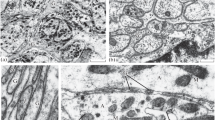Summary
The passive electrical properties, and the ionic basis of the action potential have been examined in the subumbrella myoid epithelium of the siphonophoreChelophyes. The myoepithelial cells are electrically coupled, and are 20 μm wide, some 1 mm long, and only 5 μm thick. Membrane constants determined by a 2-electrode study were: λ = 280 μm; Rm = 0.11 kOhm/cm2; Ri = 24 Ohm/cm. Mean resting potential was − 85 mV. The first action potential of a series (whether evoked by repetitive stimulation, or occurring in a natural unstimulated swimming burst) shows a rapid rise and fall with no afterpotential. The overshoot is small, but successive action potentials show a remarkable facilitation, overshooting by as much as 70 mV. They also show a plateau phase after the initial rapid rise, which is terminated by a rapid fall. Conduction velocity was 27 cm/s.
Changes in the external milieu, and the effects of Ca2+ blocking agents indicated that the action potentials are complex events. Although insensitive to TTX, the action potential is dependent on external sodium concentration, and is not abolished by Ca2+ blocking agents: in this respect it resembles the sodium-dependent action potentials of other siphonophore tissues.
The ionic basis of the facilitated action potentials is not yet clear, but it seems probable that a fast potassium conductance terminating the unfacilitated action potential is progressively inactivated during repetitive activity, and that the plateau phase of the facilitated action potential is maintained by a sodium conductance mechanism, to be terminated by a calcium-activated potassium conductance.
Similar content being viewed by others
Abbreviations
- EGTA :
-
1,2-bis-[2-di(carboxymethyl)-amino-ethoxyl]-ethane
- TEA :
-
tetraethyl ammonium chloride
- TTX :
-
tetrodotoxin
References
Anderson PAV (1979) Epithelial conduction in salps. I. Properties of the outer skin pulse system of the stolon. J Exp Biol 80:299–302
Armstrong CM (1974) Ionic pores, gates, and gating currents. Q Rev Biophys 7:179–210
Bennett MVL, Crain SM, Grundfest H (1959) Electrophysiology of supramedullary neurons inSpheroides maculatus. J Gen Physiol 43:189–219
Brady AJ, Woodbury JM (1960) The sodium-potassium hypothesis as the basis of electrical activity in frog ventricle. J Physiol (Lond) 28:385–407
Chain BM (1979) The excitable epithelia in hydroids. PhD thesis, Cambridge University
Chain BM (1981) A sodium-dependent twitch muscle in a coelenterate: the ectodermal myoepithelium of the gastrozooids inAgalma sp. (Siphonophora). J Exp Biol 90:101–108
Eisenberg RS, Johnson EA (1970) Theoretical treatment of electrical spread in thin sheet. Prog Biophys Mol Biol 20:1–65
Fitzhugh R (1960) Thresholds and plateaus in the Hodgkin-Huxley nerve equations. J Gen Physiol 43:867–896
Jack JJB, Noble D, Tsien RW (1975) Electric current flow in excitable cells. Oxford University Press, Oxford
Josephson RK, Schwab WE (1979) Electrical properties of an excitable epithelium. J Gen Physiol 74:213–236
Jongsma HS, Rijn HE van (1972) Electrotonic spread of current in monolayer cultures of neonatal rat heart cells. J Membr Biol 9:341–360
Kriebel ME (1968) Electrical characteristics of tunicate heart cell membranes and nexuses. J Gen Physiol 52:46–59
McAllister RE, Noble D, Tsien RW (1975) Reconstruction of the electrical activity of cardial B Purkinje fibres. J Physiol (Lond) 251:1–59
Mackie GO (1965) Conduction in the nerve-free epithelia of siphonophores. Am Zool 5:439–453
Mackie GO (1976) Propagated spikes and secretion in a coelenterate glandular epithelium. J Gen Physiol 68:313–325
Meech RW (1978) Calcium-dependent K+ activation in nervous tissues. Annu Rev Biophys Bioeng 7:1–18
Nakajima S, Kusano K (1966) Behaviour of delayed current under voltage clamp in the supramedullary neurones of puffer. J Gen Physiol 49:613–628
Noble D (1962) Cardiac action and pacemaker potentials based on the Hodgkin-Huxley equations. Nature 188:495–496
Shiba H (1971) The Heavyside ‘Bessel cable’ as an electric model for flat simple epithelial cells. J Theor Biol 30:59–68
Tomita T (1970) Electrical properties of mammalian smooth muscle in: Bulbring E, Brading AF, Jones AW, Tomita T (eds) Smooth muscle. Arnold, London, pp 197–243
Totton AK (1954) A synopsis of the Siphonophora. Trustees of the British Museum (Natural History), London
Author information
Authors and Affiliations
Additional information
This work was carried out during a visit to the Station Zoologique, Villefranche-sur-Mer in the spring of 1979; it is a pleasure to express our thanks to Prof. P. Bougis and his staff for their kind hospitality. Q.B. and P.A.V.A. were supported by a grant from the British Council which is gratefully acknowledged.
Rights and permissions
About this article
Cite this article
Chain, B.M., Bone, Q. & Anderson, P.A.V. Electrophysiology of a myoid epithelium inChelophyes (Coelenterata: Siphonophora). J. Comp. Physiol. 143, 329–338 (1981). https://doi.org/10.1007/BF00611170
Accepted:
Issue Date:
DOI: https://doi.org/10.1007/BF00611170



